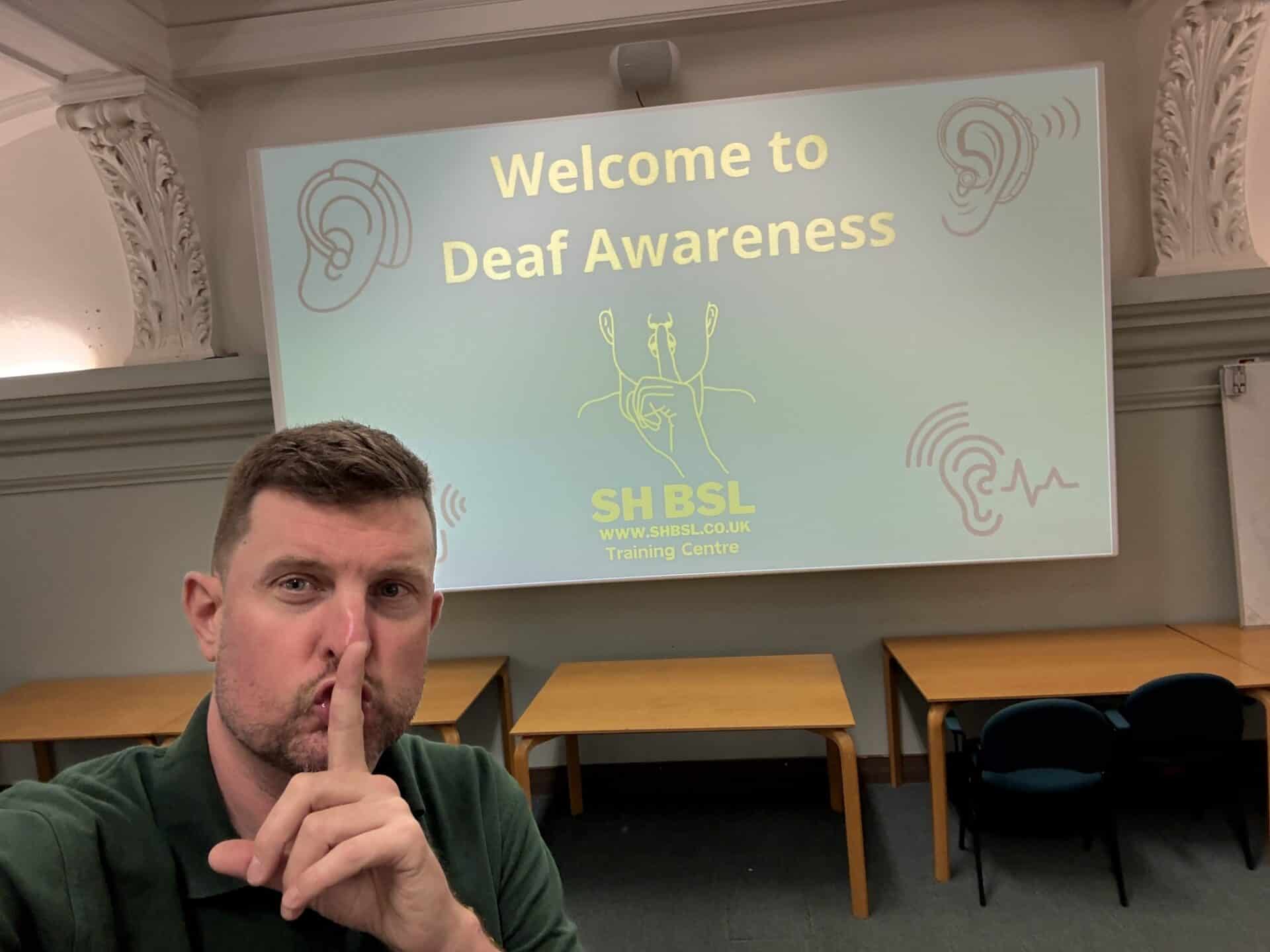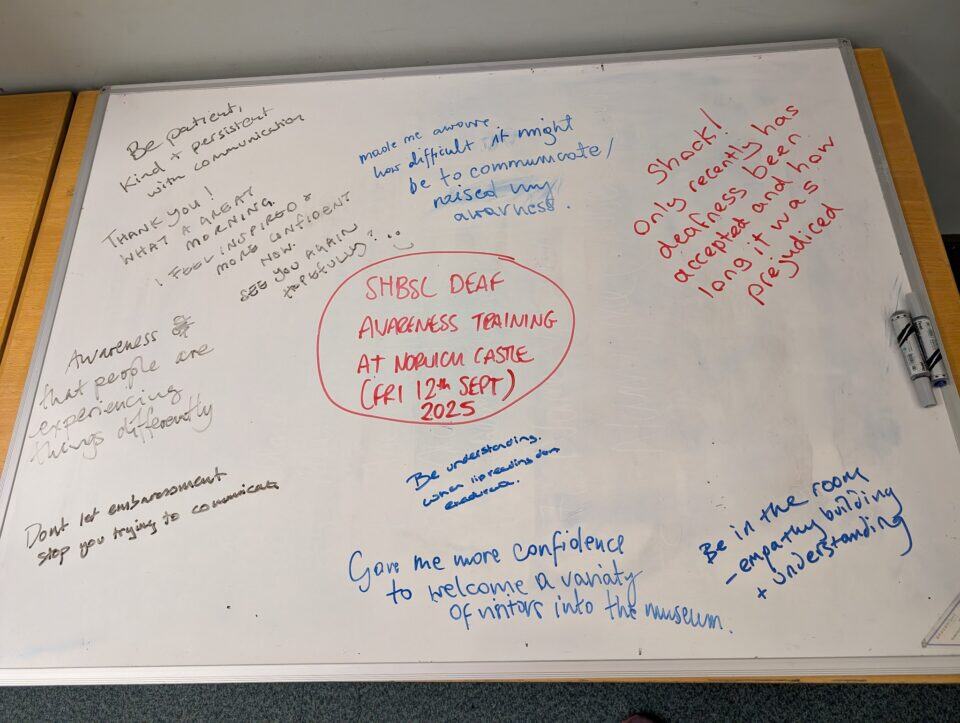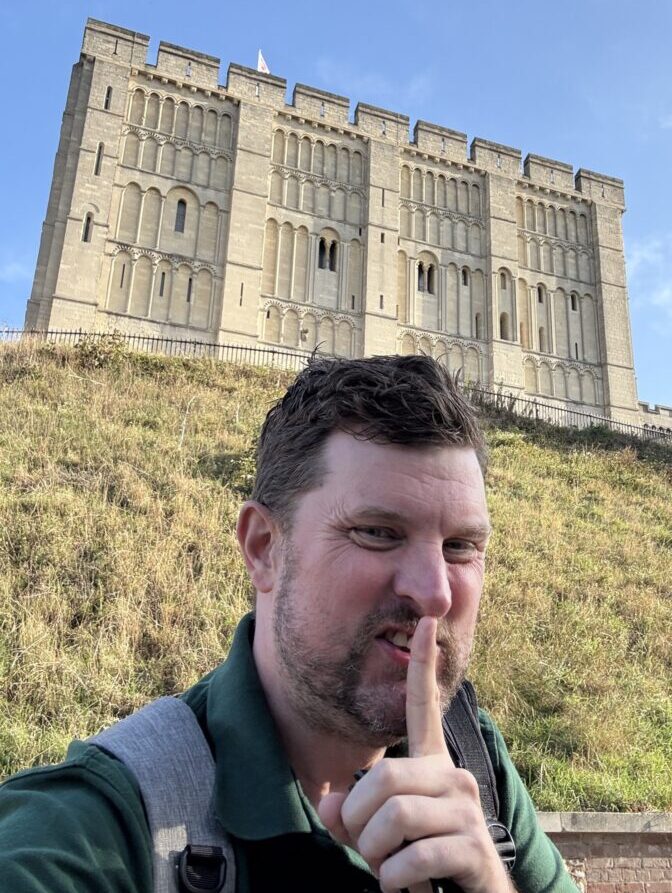About a year ago I attended a tour at Stranger’s Hall Museum in Norwich along with a group of Deaf people. This tour was Sign Language Interpreted and there were two lovely members of staff there who had some BSL skills as they had both completed their Level One course. We had some lovely chats and have kept in touch ever since keeping up with news and developments.
Over the summer break I was busy at SH BSL creating a brand new slides for our Deaf Awareness and BSL training that has been designed to be really cutting edge – modern, visually appealing and stimulating. There was much work that went into this and I was delighted with the results, a really fresh and professional approach to the subject. I couldn’t wait to use it in my training.
Out of the blue I was contacted by the Norwich Museum Service and asked if I could deliver a bespoke Deaf Awareness session for their staff on a Friday and subsequent Monday morning, two three hour sessions. I was thrilled. This was the perfect opportunity to showcase the new materials. I was delighted and very much looking forward to catching up with my friends from Strangers’ Hall in person again too.
On the first day of teaching,I was planning to arrive early to set up and snuck in the side entrance along with the staff as agreed. I had set my alarm nice and early and beat the traffic to arrive with plenty of time. First win of the day!
When I first arrived I was a little disconcerted as the room we had agreed for me to teach in was still set up for a Wedding Reception and I was not expecting that at all and have to admit I was a bit flummoxed! Ironically, I then had technical issues in that room so I was kindly moved to a bigger and even better room, which, frankly, was amazing. A large domed space with a massive interactive video screen – it was the ultimate venue to teach Deaf Awareness. Staff on hand very kindly helped me connect all my equipment and before we knew it I was good to go. SH BSL were in session.
I was happy to have access to two excellent Interpreters working remotely via SignVideo as it is so hard to get in person Interpreters these days and it worked like a dream. They worked their socks off in both sessions, making it fully accessible for all. I had 12 participants in the group and the sessions were running like clockwork.

Initially, I shared a little about my story, just enough to whet their appetite for the subject with some personal anecdotes. I only had my first real taste of BSL when I was 19 at Doncaster College – I had arrived as a very Oral (lip reading) reliant person and the impact of discovering a visually accessible language was massive, it was a seminal, pivotal, moment in my life. Prior to that I had solely relied on lip reading and to this day, I find it completely draining trying to make sense of the spoken word without BSL support.
I really like to try to teach in a way that participants can relate to and get a real flavor for what it is like as a Deaf person, giving examples of difficult words to lip read and so on. I really felt this group left with a new found empathy and depth of understanding. As part of the session I always include a section about politically incorrect and offensive phrases relating to Deafness – “Deaf & Dumb”, for example, and a local one from this area, “Luggy” and for participants to really think about the negative impact of these kinds of stereotypes.
We looked at the history of BSL and how it developed. This sounds dry, but everyone always enjoys learning about this. Obviously, though, I had a prime audience that day, with regard to anything related to history, being museum staff, so they lapped it up and got lots from it. We had two really good three hour sessions with lots of chill breaks for coffee and tea. The feedback was extremely positive from all involved.
In summary, we covered the following topics:
Deafness, what actually is it?
• Medical model; causes; cultural implications; variations; impact of being Deafened in later life; those born congenitally Deaf and so on.
Communication Methods
• Visual images of Sign Languages; communication styles; colloquial habits and accents; technology; messaging; Facetime; conference calling; pros and cons of various methods and so forth.
Communication tips
• This involved basic etiquette around Deaf people and how to attract attention, acceptable forms of touching and waving and so on,
Tasks
• I set the group 5 tasks during the session and the lip reading exercise I think was the most impactful of all.
The funniest part, for me, was when I gave them all headphones and thoughtfully added background music. I chose a group called ‘The Cure’ from the 90’s which I believe was quite popular, to make it less tempting to cheat as they wouldn’t be able to hear each other speaking. The part I wasn’t quite expecting was when the music played my two fab BSL Interpreters were bopping away as they interpreted the lyrics for me. A great example of access and equality. It was a memorable activity for all.
While they had the headphones and music playing they were given words to silently ‘mouth’ to each other and make a note of. Obviously I didn’t give them easy to lipread words either, where is the ‘fun’ in that, I wanted them to realise how hard it can be!
During the exercise they worked in pairs, one person with headphones and one without, lip speaking and lip reading. It was great to see the creativity of the participants as they tried to ‘ee-nunnn-seeeee-ate’ (enunciate) the words and somewhat desperately tried to use gestures and expressions to attempt to convey the meaning of the words they were communicating. Real learning was taking place in that exercise and it was great to see the enjoyment and realisation as the group engaged fully.
By the end of about 15 minutes the group was exhausted and had huge respect for Deaf people having to do that on a regular basis. A real eye opener!
• We also covered practical tasks in basic Sign Language in the form of greetings and so on as well as learning how to spell the alphabet on their hands, this is known as fingerspelling.
Questions & Feedback
• During the session I had shared various examples about being Deaf, from my own story and that of others and there were lots of questions regarding lived experience.
• The feedback was superb with lots of compliments on the interactive and visually appealing content.
• Most importantly everyone left with a fresh awareness of how to react and welcome someone who identifies themselves as Deaf. After all, we are all human.

If you want Deaf Awareness sessions, do get in touch with me https://shbsl.co.uk/services/deaf-awareness-course/
